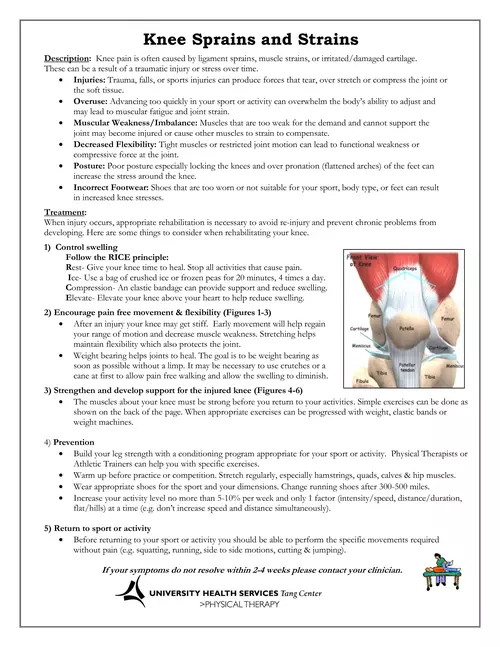
Knee Pain
Description: Knee pain is often caused by ligament sprains, muscle strains, When appropriate exercises can be progressed with weight, elastic bands or.
adsPart of the document
Knee Sprains and Strains
Description: Knee pain is often caused by ligament sprains, muscle strains, or irritated/damaged cartilage.
These can be a result of a traumatic injury or stress over time.
Injuries: Trauma, falls, or sports injuries can produce forces that tear, over stretch or compress the joint or
the soft tissue.
Overuse: $GYMQŃLQJ PRR TXLŃNO\ LQ \RXU VSRUP RU MŃPLYLP\ ŃMQ RYHUROHOP POH NRG\·V MNLOLP\ PR MGÓXVP MQG
may lead to muscular fatigue and joint strain.
Muscular Weakness/Imbalance: Muscles that are too weak for the demand and cannot support the
joint may become injured or cause other muscles to strain to compensate.
Decreased Flexibility: Tight muscles or restricted joint motion can lead to functional weakness or
compressive force at the joint.
Posture: Poor posture especially locking the knees and over pronation (flattened arches) of the feet can
increase the stress around the knee.
Incorrect Footwear: Shoes that are too worn or not suitable for your sport, body type, or feet can result
in increased knee stresses.
Treatment:
When injury occurs, appropriate rehabilitation is necessary to avoid re-injury and prevent chronic problems from
developing. Here are some things to consider when rehabilitating your knee.
1) Control swelling
Follow the RICE principle:
Rest- Give your knee time to heal. Stop all activities that cause pain.
Ice- Use a bag of crushed ice or frozen peas for 20 minutes, 4 times a day.
Compression- An elastic bandage can provide support and reduce swelling.
Elevate- Elevate your knee above your heart to help reduce swelling.
2) Encourage pain free movement & flexibility (Figures 1-3)
After an injury your knee may get stiff. Early movement will help regain
your range of motion and decrease muscle weakness. Stretching helps
maintain flexibility which also protects the joint.
Weight bearing helps joints to heal. The goal is to be weight bearing as
soon as possible without a limp. It may be necessary to use crutches or a
cane at first to allow pain free walking and allow the swelling to diminish.
3) Strengthen and develop support for the injured knee (Figures 4-6)
The muscles about your knee must be strong before you return to your activities. Simple exercises can be done as
shown on the back of the page. When appropriate exercises can be progressed with weight, elastic bands or
weight machines.
4) Prevention
Build your leg strength with a conditioning program appropriate for your sport or activity. Physical Therapists or
Athletic Trainers can help you with specific exercises.
Warm up before practice or competition. Stretch regularly, especially hamstrings, quads, calves & hip muscles.
Wear appropriate shoes for the sport and your dimensions. Change running shoes after 300-500 miles.
Increase your activity level no more than 5-10% per week and only 1 factor (intensity/speed, distance/duration,
IOMPCOLOOV MP M PLPH HBJB GRQ·P LQŃUHMVH VSHHG MQG GLVPMQŃH VLPXOPMQHRXVO\ B
5) Return to sport or activity
Before returning to your sport or activity you should be able to perform the specific movements required
without pain (e.g. squatting, running, side to side motions, cutting & jumping).
If your symptoms do not resolve within 2-4 weeks please contact your clinician.
Knee Exercises
Self Mobilization (Fig. 1)
With good leg underneath involved leg, slowly
straighten legs, hold then lower.
Hold: 10 seconds
Repeat: 10 times
Quad Sets (Fig. 2)
Tighten the muscles on the front of your thigh and
straighten the knee without locking it backwards.
Hold: 10 seconds
Repeat: 10 times
Stop if you feel pressure or pain in the knee
Hamstring Stretch (Fig. 3)
Pull the thigh towards your chest to about 90
Straighten the knee until you feel a stretch in the back
of your thigh.
Hold: 15 seconds
Repeat: 10 times
Quad Strengthening (Fig. 4)
Tighten the muscles on the front of thigh and
straighten the knee without locking it backwards.
Maintain SRVLPLRQ ROLOH \RX OLIP POH POLJO MNRXP 12µB
Hold: 10 seconds
Repeat: 3 sets of 10
Short Arc Quads (Fig. 5)
Tighten the muscles on the front of your thigh.
Straighten your knee while maintaining it on the ball
or towel roll.
Hold: 10 seconds
Repeat: 3 sets of 10
Hamstring Curl (Fig. 6)
While keeping your thigh vertical, bend your knee to
90
. After holding, lower slowly.
Hold: 10 seconds
Repeat: 3 sets of 10
Rev 9/11
Stop any exercise that increases your symptoms


